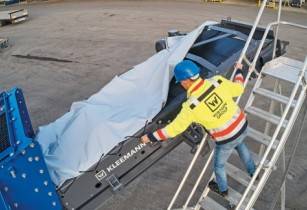Celebrating the 50 years of wheeled loading shovel manufacturing, JCB now manufactures wheeled loaders in its production facilities around the world including the UK, India, Brazil and China
This year further marks the 20th anniversary of JCB opening a multi-million-dollar factory in Cheadle, Staffordshire dedicated to the production of wheeled loaders.
Tim Burnhope, chief innovation and growth officer at JCB, said, ?Over the past 50 years, JCB?s wheeled loader range has evolved into a major part of our product portfolio. The launch of the spacious CommandPlus cab on our wheeled loaders was a pivotal moment in this machine?s history and this innovation really did put operator comfort at the heart of the design.?
JCB provides 25 different wheeled loader models and manufactures the product on three continents, Burnhope noted.
Extensive range
The first JCB-designed arrived in 1971, with the launch of the 413 and 418 models, replacing the former Chaseside models. These shovels featured a cab mounted on the front section of the articulating chassis, to provide the operator with an improved view of the working area.
At that time, JCB launched a tracked loading shovel, the 110, the first of its type to feature a hydrostatic transmission and twin tiller loader controls. The machine was the first to be awarded a Design Council Award in 1972. The crawler loader would continue to be developed, with the 112 and 114 models, well into the 70s.
In 1973, the 423 and 428 were launched, taking JCB into heavier wheeled loader territory.
By the early 1980s, the division had expanded again, with the introduction of the 428 landfill compactor. JCB recognised that different industry sectors required individual machine specifications, a focus that has remained to this day, with JCB building specific models for construction, quarrying, agriculture and waste handling. The first 410 Farm Master model would be launched just two years later in 1983, continuing a relationship with the farming community that has was established along with the company in 1945.
By that time, the 410, 420 and 430 models had arrived, moving the sector forwards with the introduction of four-ram loader linkages. These parallel lift arms would prove essential for materials handling duties in particular.
Another sector with which JCB has enjoyed a positive relationship is the military, the company developing the 410M-1B military wheeled loader in 1984. As well as being specifically designed and built to meet the needs of the military operation, each machine was shipped with US$1271.50 of spare parts, to ensure continued operation in even the most remote areas.
JCB continued to develop its growing range of wheeled loaders, moving into the compact market in 1987. The 406 was the first JCB compact loader and the first to have the cab mounted on the rear section of the articulating chassis. This model was soon joined by the 408 in 1989 and the 408 Farm Master in 1990.
JCB redesigned its heavier loaders, with the launch of the 411, 412S and 416 in 1994. These new machines all featured a much-improved operator?s cab, mounted on the rear section of the chassis for the first time. They were followed just a year later by the 414S, 426, 436ZX and JCB?s first telescopic boom wheeled loader, the 409TM.
In 1997, JCB picked up a Queen?s Award for Export Achievement for the loader range, along with a Royal Agricultural Society of England Silver Medal Award for the 412 Farm Master Servo Plus. A new range-topping 456ZX model joined the line-up, alongside 410ZX and 411ZX hydrostatic compact models and two additional Telemasters - the TM200 and TM270.
By the early 2000s, the company?s range of wheeled loaders and telescopic loaders was well established, with the addition of new 407, 408 and 409 hydrostatic loaders, the TM300 Telemaster and the 456HT loader. In 2006, JCB Earthmovers was again given a Queen?s Award for Enterprise, in the International Trade Category, a feat that would be repeated in 2009.
The company?s Dieselmax engine range, fitted to a number of the loaders, went on to power the firm?s Dieselmax streamliner to a world land-speed record for diesel cars in 2006, establishing JCB as a world-beating engine manufacturer.
The first decade of the new century culminated with the launch of the 436E-M (military) and 436E-MWW (medium winterised waterproof) military wheeled loaders, with the MWW variant the first to be completely waterproofed and winterised.
As with other JCB businesses, much of the second decade of this century has been taken up with meeting exhaust emissions legislation, as JCB?s wheeled loaders have passed through Tier 3 and Tier 4 Interim and Final standards. The company is currently preparing to provide customers in Europe with Stage V compliant models in 2019 and 2020.
In 2014, the company launched the ?JCB CommandPlus? cab. The JCB 457 was the first machine to show off the completely new cab, offering operators the ultimate in comfort. This totally new ROPS structure has A-pillars that have been moved out to the same width as the rear of the cab, providing a larger interior with a panoramic front windscreen. The machine features JCB?s Command Driving Position, with revised pedals, a new adjustable steering column, and seat-mounted hydraulic controls.
The company is now readying its extensive range to meet the needs of tomorrow?s customers, with the introduction of Stage V emissions compliant powertrains.



























